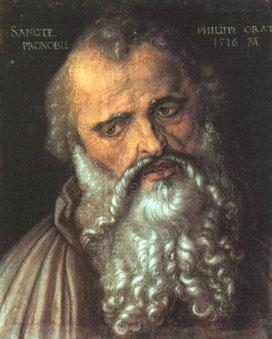| St. Philip  Born: fl. 1st c. AD Born: fl. 1st c. AD
Died: fl. 1st c. AD
Cause of death: unspecified
Gender: Male
Religion: Roman Catholic
Race or Ethnicity: White
Occupation: Religion Nationality: Palestine
Executive summary: Apostle of Jesus Philip, one of the twelve apostles, mentioned fifth in all the lists. He is a mere name in the Synoptists, but a figure of some prominence in the Fourth Gospel. There he is said to have been "of Bethsaida, the city of Andrew and Peter", and to have received his call to follow Jesus at Bethany, having previously been, it would seem, a disciple of the John the Baptist. Philip was at that time the means of bringing Nathanael to Jesus, and at a later date he, along with Andrew, carried the request of the inquiring Greeks to the Master. Philip and Andrew alone are mentioned by name in connection with the feeding of the five thousand, and Philip is also one of the few interlocutors in John 14. Slight though these references are, all agree in presenting Philip as of an inquiring and calculating character, slow to take the initiative, but, when convinced of the path of duty, thoroughly loyal in following it. After the resurrection he was present at the election of Matthias as successor to Judas, but he does not again appear in the New Testament history; it is, however, implied that he still continued in Jerusalem after the outbreak of the first persecution.
Little reliance can be placed on the traditional accounts of Philip, owing to the evident confusion that had arisen between him and the evangelist of the same name, who appears in the book of Acts. According to Polycrates, bishop of Ephesus, in his controversial letter written to Victor of Rome towards the end of the 2nd century, the graves of Philip "of the twelve apostles", and of his two aged virgin daughters were in (the Phrygian) Hierapolis; a third daughter, "who had lived in the Holy Ghost", was buried at Ephesus. With this may be compared the testimony of Clement of Alexandria, who incidentally speaks of "Philip the Apostle" as having begotten children and as having given daughters in marriage. On the other hand, Proclus, one of the interlocutors in the "Dialogue of Caius", a writing of somewhat later date than the letter of Polycrates, mentions "four prophetesses, the daughters of Philip at Hierapolis in Asia, whose tomb and that of their father are to be seen there", where the mention of the daughters prophesying identifies the person meant with the Philip of Acts (cf. Acts 21:8). The reasons for setting aside this latter identification, and for holding that the Philip who lived at Hierapolis was the Apostle are clearly stated by Lightfoot, Colossians (2) note 3, p.45 seq., and fresh confirmation of his view was afforded by the discovery of an inscription at Hierapolis, showing that the church there was dedicated to the memory "of the holy and glorious apostle and theologian Philip."
A later stage of the tradition regarding Philip appears in various late apocryphal writings which have been edited by Tischendorf in his Acta apostolorum apocrypha, and in his Apocalypses apocryphae. According to the Acta Philippi, a work belonging at the earliest to the close of the 4th century, Philip, with Bartholomew and his own sister Mariamne, exercised a widespread missionary activity, preaching not only throughout Asia Minor, but also in Hellas the city of the Athenians, in Scythia, and in Gaul, etc. According to one account he died a natural death; according to another he was hanged or crucified, head downwards. An apocryphal gospel, which describes the progress of the soul through the next world, bears his name.
Since the 6th century Philip has been commemorated in the West, along with St. James the Less, on the 1st of May, their relics being deposited in the same church in Rome; in the Eastern Church Philip's day is the 14th of November, and that of James the Less the 23rd of October.
Biblical Figures
Do you know something we don't?
Submit a correction or make a comment about this profile
Copyright ©2019 Soylent Communications
|